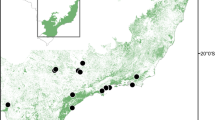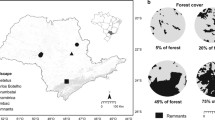Abstract
Habitat loss threatens biodiversity in tropical forests, having harmful effects on population dynamics and, ultimately, determining the evolutionary destiny of species. Thus, understanding how habitat loss affects microevolutionary processes is an important step in the conservation of genetic resources. However, few studies have explored landscape genetics for plants in tropical environments. Our study evaluated the effects of a landscape-scale reduction in forest cover on genetic diversity and structure of Euterpe edulis (Arecaceae). The research was conducted in Atlantic Forest landscapes in Northeastern Brazil. We randomly chose 16 forest sites, each located in a 13 km2 landscape with forest cover ranging from 6 to 83 %. After a survey of adults and seedlings in each sampling site, we found a minimum of five individuals of E. edulis at nine sites and sampled leafs from all adults within a 15 × 400 m plot and all seedlings within a 2 × 400 m subplot in each sampling site. We found that the gradient of remaining forest cover at the landscape scale did not affect the genetic diversity measured by any of the descriptors analyzed and each sampling site still harbored populations with high levels of genetic variability. However, we detected the presence of two distinct genetic groups with signs of admixture; the structural pattern of these groups differed between adults and seedlings, mainly in less forested landscapes areas. We believe that E. edulis is a good example of a tropical palm that is experiencing local extirpation before suffering loss of genetic alterations.



Similar content being viewed by others
References
Andrén H (1994) Effects of habitat fragmentation on birds and mammals in landscapes with different proportions of suitable habitat: a review. Oikos 71:355–366
Balkenhol N, Gugerli F, Cushman SA et al (2009) Identifying future research needs in landscape genetics: where to from here? Landsc Ecol 24:455–463. doi:10.1007/s10980-009-9334-z
Blanquart F, Gandon S, Nuismer SL (2012) The effects of migration and drift on local adaptation to a heterogeneous environment. J Evol Biol 25:1351–1363. doi:10.1111/j.1420-9101.2012.02524.x
Brooks TM, Mittermeier RA, Mittermeier CG et al (2002) Habitat loss and extinction in the hotspots of biodiversity. Conserv Biol 16:909–923. doi:10.1046/j.1523-1739.2002.00530.x
Carvalho CS, Ribeiro MC, Côrtes MC, Galetti M, Collevatti RG (2015) Contemporary and historic factors influence differently genetic differentiation and diversity in a tropical palm. Heredity. doi:10.1038/hdy.2015.30
Conte R, Sedrez dos Reis M, Mantovani A, Vencovsky R (2008) Genetic structure and mating system of Euterpe edulis Mart. populations: a comparative analysis using microsatellite and allozyme markers. Heredity 99:476–482. doi:10.1093/jhered/esn055
Cordeiro NJ, Howe HF (2001) Low recruitment of trees dispersed by animals in African forest fragments. Conserv Biol 15:1733–1741. doi:10.1046/j.1523-1739.2001.99579.x
Cushman SA, Shirk A, Landguth EL (2012) Separating the effects of habitat area, fragmentation and matrix resistance on genetic differentiation in complex landscapes. Landsc Ecol 27:369–380. doi:10.1007/s10980-011-9693-0
Doyle JJ, Doyle JL (1987) Isolation of plant DNA from fresh tissue. Focus 12:13–15
Earl DA, VonHoldt BM (2012) STRUCTURE HARVESTER: a website and program for visualizing structure output and implementing the Evanno method. Conserv Genet Resour 4:359–361. doi:10.1007/s12686-011-9548-7
Evanno G, Regnaut S, Goudet J (2005) Detecting the number of clusters of individuals using the software STRUCTURE: a simulation study. Mol Ecol 14:2611–2620. doi:10.1111/j.1365-294X.2005.02553.x
Fahrig L (2002) Effect of habitat fragmentation on the extinction threshold: a synthesis. Ecol Appl 12:346–353
Fahrig L (2003) Effects of habitat fragmentation on biodiversity. Annu Rev Ecol Evol Syst 34:487–515. doi:10.1146/annurev.ecolsys.34.011802.132419
Funk WC, Murphy MA (2010) Testing evolutionary hypotheses for phenotypic divergence using landscape genetics. Mol Ecol 19:427–430. doi:10.1111/j.1365-294X.2009.04466.x
Gaiotto FA, Brondani RPV, Grattapaglia D (2001) Microsatellite markers for heart of palm—Euterpe edulis and E. oleracea Mart. (Arecaceae). Mol Ecol Notes 1:86–88
Gaiotto FA, Grattapaglia D, Vencovsky R (2003) Genetic structure, mating system, and long-distance gene flow in heart of palm (Euterpe edulis Mart.). Heredity 94:399–406. doi:10.1093/jhered/esg087
Galetti M, Fernandez JC (1998) Palm heart harvesting in the Brazilian Atlantic forest: changes in industry structure and the illegal trade. J Appl Ecol 35:294–301
Galetti M, Guevara R, Côrtes CM et al (2013) Functional extinction of birds drives rapid evolutionary changes in seed size. Science 340:1086–1090
Herrera JM, García D (2010) Effects of forest fragmentation on seed dispersal and seedling establishment in ornithochorous trees. Conserv Biol 24:1089–1098. doi:10.1111/j.1523-1739.2010.01459.x
Holderegger R, Wagner HH (2008) Landscape genetics. Bioscience 58:199. doi:10.1641/B580306
Holderegger R, Buehler D, Gugerli F, Manel S (2010) Landscape genetics of plants. Trends Plant Sci 15:675–683. doi:10.1016/j.tplants.2010.09.002
Holzhauer SIJ, Ekschmitt K, Sander AC, Dauber J, Wolters V (2006) Effect of historic landscape change on the genetic structure of the bush-cricket Metriopteraroeseli. Landsc Ecol 21:891–899. doi:10.1007/s10980-005-0438-9
Jordano P, Galetti M, Pizo MA, Silva WR (2006) Ligando frugivoria e dispersão de sementes à biologia da conservação. Biol da Conserv Essências, Editor Rima, São Paulo, pp 1–26
Junior LRN, Fisch STV, Ballestero SD (2003) Influência da umidade do solo no desenvolvimento inicial de plantas do palmiteiro Euterpe edulis Mart. em Floresta Nativa. Rev Biociênc Taubaté 9:7–13
Klank C, Ghazoul J, Pluess AR (2012) Genetic variation and plant performance in fragmented populations of globeflowers (Trollius europaeus) within agricultural landscapes. Conserv Genet 13:873–884. doi:10.1007/s10592-012-0337-y
Landguth EL, Cushman SA, Schwartz MK et al (2010) Quantifying the lag time to detect barriers in landscape genetics. Mol Ecol 19:4179–4191. doi:10.1111/j.1365-294X.2010.04808.x
Leitman P, Henderson A, Noblick L, Soares K (2013) Lista de Espécies da Flora do Brasil. In: Jardim Botânico do Rio Janeiro. http://floradobrasil.jbrj.gov.br/jabot/floradobrasil/FB15712. Accessed 20 Mar 2014
Lewis PO, Zaykin D (1999) Genetic data analysis: computer program for the analysis of allelic data. Version 1.0 (d12). Distributed by the authors @http://alleyn.eeb.uconn.edu/gda
Lôbo D, Leão T, Melo FPL et al (2011) Forest fragmentation drives Atlantic Forest of northeastern Brazil to biotic homogenization. Divers Distrib 17:287–296. doi:10.1111/j.1472-4642.2010.00739.x
Lowe A, Boshier D, Ward M et al (2005) Genetic resource impacts of habitat loss and degradation; reconciling empirical evidence and predicted theory for neotropical trees. Heredity 95:255–273. doi:10.1038/sj.hdy.6800725
Manel S, Schwartz MK, Luikart G, Taberlet P (2003) Landscape genetics: combining landscape ecology and population genetics. Trends Ecol Evol 18:189–197. doi:10.1016/S0169-5347(03)00008-9
Manel S, Joost S, Epperson BK et al (2010) Perspectives on the use of landscape genetics to detect genetic adaptive variation in the field. Mol Ecol 19:3760–3772. doi:10.1111/j.1365-294X.2010.04717.x
Martinelli G, Moraes MA (2013) Livro vermelho da flora do Brasil, 1st edn. Instituto de Pesquisas Jardim Botânico do Rio de Janeiro, Rio de Janeiro, pp 187–195
Martini AMZ, Fiaschi P, Amorim AM, da Paixão JL (2007) A hot-point within a hot-spot: a high diversity site in Brazil’s Atlantic Forest. Biodivers Conserv 16:3111–3128. doi:10.1007/s10531-007-9166-6
Matos DMS, Freckleton RP, Watkinson AR (1999) The role of density dependence in the population dynamics of a tropical palm. Ecology 80:2635–2650
Moran C, Catterall CP (2014) Responses of seed-dispersing birds to amount of rainforest in the landscape around fragments. Conserv Biol 28:551–560. doi:10.1111/cobi.12236
Morante-Filho JC, Faria DM, Mariano-Neto E, Rhodes J (2015) Birds in anthropogenic landscapes: the responses of ecological groups to forest loss in the Brazilian Atlantic Forest. PLoS ONE. doi:10.1371/journal.pone.0128923
Mori SA, Boom BM, de Carvalho AM, dos Santos TS (1983) Southern Bahian moist forests. Bot Rev 49:155–232
Oliveira-filho AT, Fontes MA (2000) Patterns of floristic differentiation among Atlantic Forests in southeastern Brazil and the influence of climate. Biotropica 32:793–810
Peakall R, Smouse PF (2012) GenAlEx 6.5: genetic analysis in Excel. Population genetic software for teaching and research—An update. Bioinformatics 28:2537–2539. doi:10.1111/j.1471-8286.2005.01155.x
Pritchard JK, Stephens M, Donnelly P (2000) Inference of population structure using multilocus genotype data. Genetics 155:945–959
Ribeiro MC, Metzger JP, Martensen AC et al (2009) The Brazilian Atlantic Forest: how much is left, and how is the remaining forest distributed? Implications for conservation. Biol Conserv 142:1141–1153. doi:10.1016/j.biocon.2009.02.021
Sommer S, McDevitt AD, Balkenhol N (2013) Landscape genetic approaches in conservation biology and management. Conserv Genet 14:249–251. doi:10.1007/s10592-013-0473-z
Storfer A, Murphy MA, Spear SF et al (2010) Landscape genetics: where are we now? Mol Ecol 19:3496–3514. doi:10.1111/j.1365-294X.2010.04691.x
Tabarelli M, Silva J, Gascon C (2004) Forest fragmentation, synergisms and the impoverishment of neotropical forests. Biodivers Conserv 13:1419–1425
Terborgh J, Nuñez-Iturri G, Pitman NC et al (2008) Tree recruitment in an empty forest. Ecology 89:1757–1768
Thomas WMW, de Carvalho AMV, Amorim AA et al (1998) Plant endemism in two forests in southern Bahia, Brazil. Biodivers Conserv 322:311–322
Vranckx G, Jacquemyn H, Muys B, Honnay O (2012) Meta-analysis of susceptibility of woody plants to loss of genetic diversity through habitat fragmentation. Conserv Biol 26:228–237. doi:10.1111/j.1523-1739.2011.01778.x
Wright S (1965) The interpretation of population structure by F-statistic with special regard to systems of mating. Evolution 19:39–420
Young A, Boyle T, Brown T (1996) Population genetic consequences of consequences of the population genetic habitat fragmentation for plants. Trends Ecol Evol 11:413–418
Acknowledgments
The authors thank Conselho Nacional de Desenvolvimento Científico e Tecnológico (CNPq) (Grant No. 563216/2010-7) and Universidade Estadual de Santa Cruz (UESC) (Grant No. 00220.1100.1320) for financing support. We also thank Coordenação de Aperfeiçoamento de Pessoal de Nível Superior (CAPES) for fellowships to the authors ASS and JCMF, and CNPq for fellowships to the authors DF and FAG. We acknowledge the team of REDE SISBIOTA and the conservation genetics group (UESC) for their helpful scientific discussions, Jéssica Souza for her help with the laboratory analysis, Ícaro Menezes Pinto for his field assistance. We also thank Dr. Jaco Le Roux and anonymous reviewers for valuable comments and suggestions on earlier version of this paper. This is publication number 9 of the REDE SISBIOTA (CNPq 563216/2010-7).
Conflict of interest
The authors declare no conflicts of interest.
Author information
Authors and Affiliations
Corresponding author
Rights and permissions
About this article
Cite this article
Santos, A.S., Cazetta, E., Morante Filho, J.C. et al. Lessons from a palm: genetic diversity and structure in anthropogenic landscapes from Atlantic Forest, Brazil. Conserv Genet 16, 1295–1302 (2015). https://doi.org/10.1007/s10592-015-0740-2
Received:
Accepted:
Published:
Issue Date:
DOI: https://doi.org/10.1007/s10592-015-0740-2




